15 Little Known Facts About Cotton Candy
 Fluffy and colorful, cotton candy is a fairground staple and one of the most
iconic treats for circuses. Most people know that cotton candy is nothing more
than spun sugar with some color added to it. That doesn't stop it from being
extremely popular. Even people that don't tend to at least buy one while they
are at an amusement park. Either made fresh or in a bag, cotton candy is
something that almost everyone does as part of their summer park, fair, or
festival experience. Fluffy and colorful, cotton candy is a fairground staple and one of the most
iconic treats for circuses. Most people know that cotton candy is nothing more
than spun sugar with some color added to it. That doesn't stop it from being
extremely popular. Even people that don't tend to at least buy one while they
are at an amusement park. Either made fresh or in a bag, cotton candy is
something that almost everyone does as part of their summer park, fair, or
festival experience.
Unlike most other festival treats, cotton candy is light and doesn't leave
one feeling as though they are sluggish or bloated from sugar or fat. However it
tastes far sweeter and more substantial than other sugary treats. This is a bit
of a downside if you're not a fan of sweets. It's also not something that you
can bring on a water ride. Cotton candy does also not hold up to water very well
as it becomes a crystallized, sticky mess.
The machines that make cotton candy take a small amount of sugar and spin it,
incorporating air into the mix. When made fresh, it's usually gathered onto a
cone, but these days you can buy cotton candy from the grocery store for any
occasion. Over the Easter holiday, it's common to find little pastel colored
tubs of the stuff waiting near the checkout lines with little bunnies or chicks
on them. However you enjoy cotton candy, there are some interesting
facts about it that you may not know.
15) Cotton Candy is a Great Science Project
Cotton candy is fluffy because it
is actually sugar that is spun in a machine that is shaped like an angel food
cake pan. The process for making it is extremely simple. There are three ways to
prepare the sugar before it is heated and spun. The first two ways allow you to
add fully colored sugar to the machine. The first step is to lay out the sugar
and roll it with a food coloring agent. Dry will work best because when sugar is
introduced to water the chemical composition changes. This causes the sugar to
melt and it will become a bit more difficult to work with. If that doesn't suit
your fancy, you can also buy pre-colored sugar online or at most party stores.
You can also add the color and the sugar to the machine separately, this is an
easy method but will not always produce a uniform color.
Making Cotton Candy:
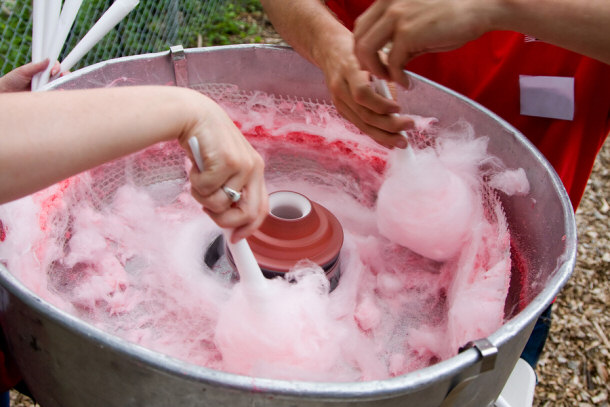
Inside the reservoir is a heating element. These days we use something that's
similar to a toaster's coils. The reason that you heat the sugar up is the same
reason that cotton candy is lighter than a similar sized bag of feathers. The
sugar gets heated to a little over 190 degrees Fahrenheit by the coils. Sugar's
melting point is 190, if you were curious. Then, the melted, colored sugar gets
pulled through small holes in the reservoir. While that is happening, the
outside pan of the machine is spinning. Like the carnival ride that is also
popular at fairs, the cotton candy is pulled out towards the sides of the
machine by centrifugal force.
This will form small threads of glass because the sugar will cool very
quickly. All there is left to do is collect the cotton candy either in a
cone, a bag, or by scooping. That's all there is to making it, simple
centrifugal force.
14) There is Less Sugar in Cotton Candy Than in Soda
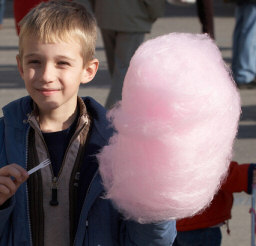 Cotton candy has two
ingredients, air and colored sugar. Because of this, there simply isn't much
there that adds up in calories. An average 12 ounce can of soda pop contains 39 grams of
sugar and 140 calories. It's a much heavier treat than many other sweets because
it's a dense liquid that contains a lot of syrup and sweetening agents. You are
also compacting the mass within a 12 ounce can. When you drink soda you
also are introducing the sugar into your bloodstream faster because it is a
liquid and not a solid. Liquids takes less time to be absorbed by your body
because there is little that your stomach has to break down. Cotton candy has two
ingredients, air and colored sugar. Because of this, there simply isn't much
there that adds up in calories. An average 12 ounce can of soda pop contains 39 grams of
sugar and 140 calories. It's a much heavier treat than many other sweets because
it's a dense liquid that contains a lot of syrup and sweetening agents. You are
also compacting the mass within a 12 ounce can. When you drink soda you
also are introducing the sugar into your bloodstream faster because it is a
liquid and not a solid. Liquids takes less time to be absorbed by your body
because there is little that your stomach has to break down.
By contrast the method that creates cotton candy puts more air than sugar
into the sweet. When you munch on cotton candy, you are eating mostly air. This
is because the centrifugal force that makes the cotton candy pulls air into the
threads. If scooped out correctly, the cotton candy will look fluffy and light.
Because of this process, a large cone of cotton candy will contain far less
sugar than a can of soda. This isn't proven in the taste, however, as many
people report that cotton candy tastes much more sugary than soda pop. The
simple reasoning for this, however, is that all there is to taste is sugar. Soda
pop has water, carbonation, and a number of other additives that will mute the
taste of sugar. Also, in the United States, most soda pops are not made with
real sugar at all and instead are made with genetically modified imitations
(high fructose corn syrup) that are not as sweet as
the original sugar cane.
13) Dec. 7 is National Cotton Candy Day
December is a very strange time to
think of cotton candy for most people. This is probably because it's always been
associated with summertime events and festivities. Any time that most people
have eaten cotton candy has been at a circus, or a carnival of some kind. The
smells, sounds, and feelings that are associated with cotton candy are all very
summery things.
Cotton Candy Sky on December 7th:

There is also a change in air pressure and temperature that makes it
difficult to make cotton candy when it becomes very cold. Remember, the time it
takes the sugar to dry again after it has been melted is what makes the glass
"strings" that are rolled together to make cotton candy. If the cotton
candy cools too soon, you won't be able to make it, let alone eat it. This is
because air that is too cold will either clump up your sugar around the
reservoir or make globs stick to the bottom of your pan.
So why is Dec. 7 the chosen day that the United States celebrates cotton
candy? To be honest, no one really knows. Some people surmise that it may be the
birthday or another important date for the creator of the treat or someone else
important in the history of cotton candy. This has never been confirmed by any
sources. Another, far less commemorative possibility is that people missed
cotton candy in the winter and wanted an excuse to eat it.
12) Cotton Candy is a Product of the Industrial Revolution
While "spun sugar"
was popular among the wealthy in the mid to late 19th century, and is usually
presumed to be the same as cotton candy as we know it today, the present-day
treat is in fact a very different thing. While spun sugar was made by drizzling
caramelized sugar onto a broom handle to work into shapes and patterns, cotton
candy is caramelized sugar run through a centrifuge to create a treat that's
over 50% air. This wasn't possible until the early twentieth century, most
notably 1899, when the recent technological advances allowed John C. Warton and
William J. Morrison (a candy maker and a dentist, respectively), to invest in
and patent "certain new and useful improvements on candy machines."
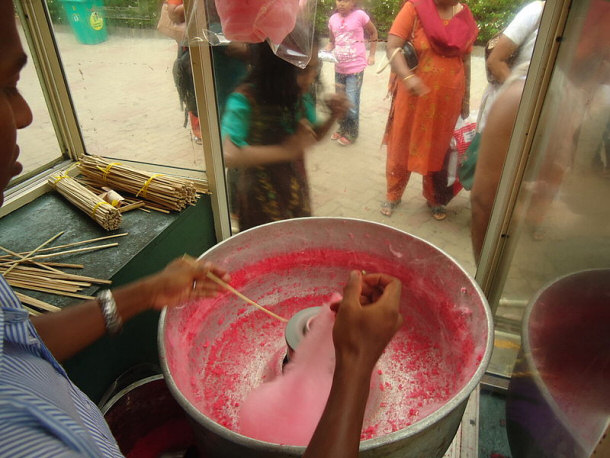
By RanjithSiji (Self) [GFDL or CC-BY-3.0],
via Wikimedia Commons
This newly improved candy machine was intended for the creation of spun
sugar, as it had been known until that point; it replaced the pan-over-fire
technique with heating via an electrical heating element, and replacing flinging
the liquid with a fork over household cleaning accessories with a funnel
perforated with thousands of minuscule holes, through which the caramelized
sugar was pushed through with such force and speed it cooled without being
allowed to recrystallize. The spun sugar of the present day incorporates special
ingredients to keep this from happening – Warton and Morrison’s "fairy floss"
machine achieved this with nothing but electricity and air, resulting in a
confectionery that, while similar to its stovetop predecessor, was also
inherently different in structure, texture and technique, and achievable only
through the sudden technological advances in the late 19th and early 20th
centuries.
11) Fairy Floss
If you leave the united states and attend a fair in another
part of the world, asking for cotton candy may get you a confused stare and a
tilted head. Before the name was changed to cotton candy in the 1920s it was
named "fairy floss." It wasn't called this because it was a treat that people
ate at fairs. Instead it was called that because it reminded people of magic.
Centrifugal force was not commonly understood at the time, so to watch cotton
candy being made was something like watching a magic trick. The small, delicate
looking candy fibers then clumped up to become a fluffy ball that is remarkably
like a cloud.
Fluffy Treat!
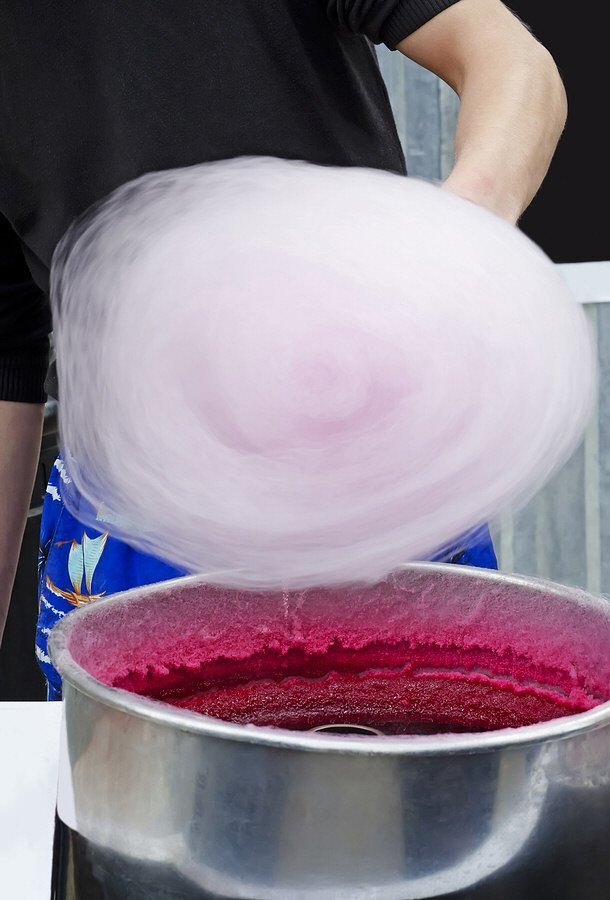
These facts were then coupled with the idea that this sweet treat for young
children earned it the name "fairy floss." In some parts of the world, the name
stuck much like the strands of sugar to each other. Australia, Finland, and
Norway all call this treat Fairy Floss. Lately there's been a bit of a movement back
to the name in the United States, but it's unsure of how that will hold up. Most
of us don't remember a time where it was called anything else but cotton candy.
That and it's not very uncommon for food items to have different names depending
on the country that you are having it at.
10) "Fairy Floss" was First Publicly Sold at the 1904 World’s Fair
Warton and
Morrison apparently spent some time perfecting their new sugar-spinning machine,
because the cotton candy we know today didn’t make its public debut until five
years after their patent was filed, at the St. Louis World’s Fair in 1904. Here,
the pair created and sold this "new" sugary delight alongside other newly
publicized present day staples such as iced tea, hot dogs served in buns and the
familiar ice cream cone. Fairy Floss was sold for twenty-five cents per box; at
half the price of admission to the fair itself, and the equivalent of $6.00
today, this was a hefty cost for a serving scooped out and served in a small
wooden box.
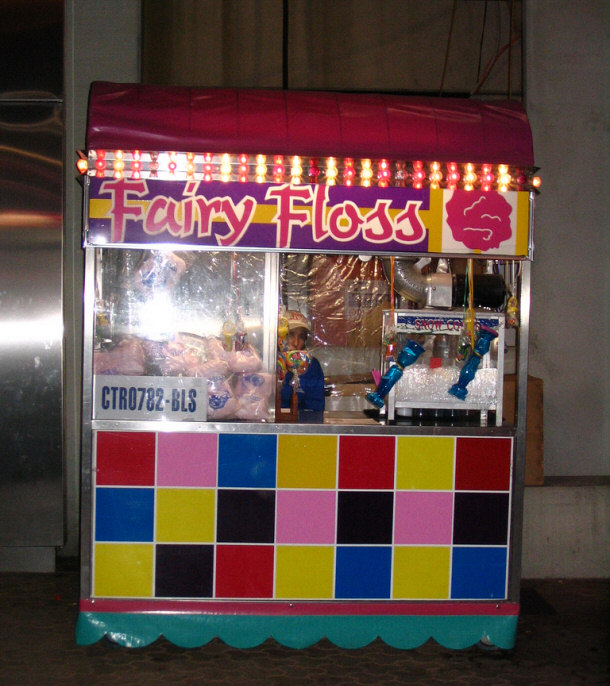
Regardless of price, their newly-titled Fairy Floss was a huge hit with the
visitors to the Fair, many of whom had never had the opportunity to taste its
precursor, spun sugar, due to class and cost restrictions of the time—sugar was
expensive, and the time and skill necessary to create it were luxuries rarely
afforded to the working class. During the exposition’s six month run, Warton and
Morrison sold close to 70,000 boxes, making over $17,000 with their new
technological confectionery marvel. Today, this would be equivalent to more than
$400,000, or more than $2,000 in sales and close to 400 boxes of candy sold per
day.
9) Tootsie Roll
Tootsie Roll is a Canadian company that became famous for its
chewy brand of chocolate candy called, unsurprisingly enough, a tootsie roll.
The company started in Chicago where it marketed individually wrapped penny
candies. The penny candies became dime candies with inflation and now you can
find most of the same in bulk forms priced by the pound. As the company expanded,
they began to look for more products to include in its inventory.
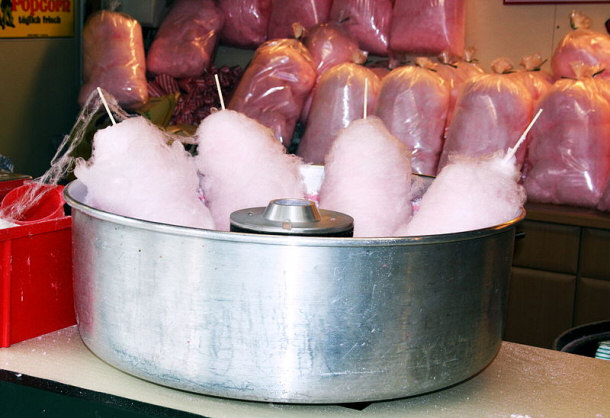
By Usien (Own work) [GFDL or CC-BY-SA-3.0-2.5-2.0-1.0],
via Wikimedia Commons
This added to them picking up cotton candy and now Tootsie Roll is the
largest cotton candy manufacturer in the world. The cotton candy that they mass
produce is the bagged variety that you can find at some large amusement parks
and convenience stores. In an attempt to enliven a candy that hasn't changed the
way that it was made since it was invented, Tootsie Roll created a fruit
flavored cotton candy that they named Fluffy Stuff. This is typically the kind
that you will find for holidays. Snow Balls come out for Christmas, Spider Webs
for Halloween, and Cotton Tails for Easter are the most popular varieties.
8) Cotton Candy Has Not Changed Much
|
Centrifugal force Inside the Gravitron ride:

Works similar to a cotton candy machine!
|
Even though you can now buy it mass
produced and packaged, cotton candy has not changed much at all since it was
invented. Many say that this is because it was a simple, fairly flawless design
to begin with. While we can now buy all sorts of flavors and colors,
centrifugal force still plays the major role in creating cotton candy. At the
time of this article, there simply hasn't been a better way to make it.
Centrifugal force is the apparent force that draws a rotating body away from
the center of its rotation. The rotating body creates a pull that will move
objects away from the center. This is why it is called an apparent force, you
can see what it is doing. Think about the ride at the fair where you line up and
put your backs to a wall in a round room. You're able to look at everyone who is
with you because you are all facing the center area. Though the center will not
move at all, the room will spin and you will find yourself pressed to the wall,
sliding up to the ceiling. This is an excellent example of how centrifugal force
works and, in reality, you're just in a giant cotton candy machine.
7) Cotton Candy is a Fat Free Food
Since there is nothing in cotton candy
other than sugar, there is actually no fat content at all. This is not to say
that there are no calories in sugar. Just about everything we consume has calories in
it. However, if you are counting fats or trans fats of any kind, you are safe
when you munch on cotton candy. This is not always true for the packaged versions
of the candy however, so you want to be careful when you look at the packaging.
Certain preservatives and flavors can have fat content in them.
Bags of Cotton Candy:
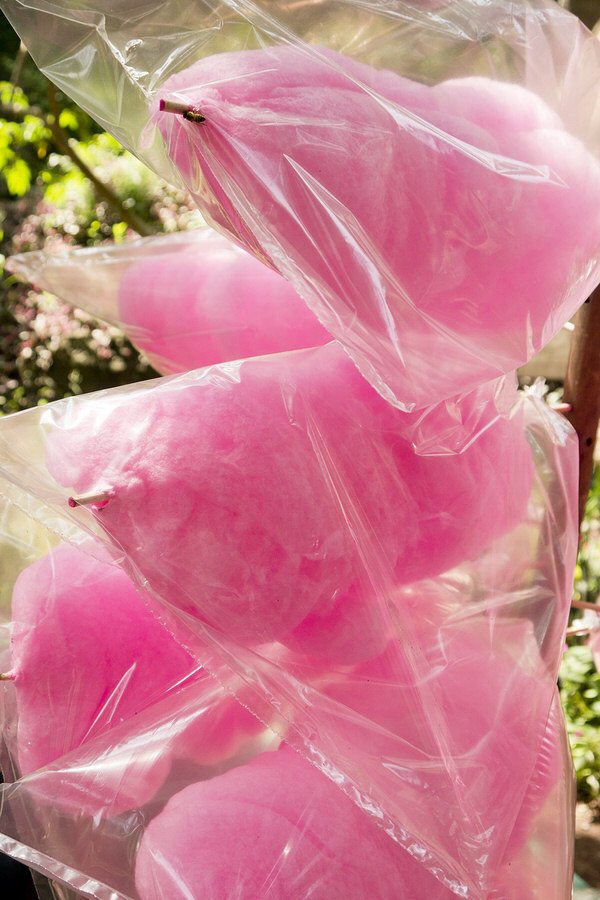
However, you can pretty much rest assured that when you are consuming cotton
candy at a fair you are not getting any unwanted fats in your day. Though,
if you are going to a fair and eating any of the common foods while you are
there, you are probably not overly concerned with fat content. Most of the
treats you are going to eat are laced with plenty of full fat and trans fats to
take you on a marathon if you needed to.
6) East Asian Candy Art
 Although rarely seen this side of the Pacific, the
various candy industries of East Asia seem to have found an artistic niche in
the glamorization of cotton candy. Often seen at fairs, street side in tourist
locations, and various other busy locations, Japanese and Chinese cotton candy
vendors have turned the spinning of sugar from something simple and easy into a
form of art so popular that classes in the techniques utilized are offered in a
number of large cities. Although rarely seen this side of the Pacific, the
various candy industries of East Asia seem to have found an artistic niche in
the glamorization of cotton candy. Often seen at fairs, street side in tourist
locations, and various other busy locations, Japanese and Chinese cotton candy
vendors have turned the spinning of sugar from something simple and easy into a
form of art so popular that classes in the techniques utilized are offered in a
number of large cities.
The sugar is spun into a stick--not the paper cones now seen at most western
fairs--and shaped with toothpicks, chopsticks, tongs and other wooden
instruments to make a number of different shapes and patterns; this is done
while the candy is still warm enough to be pliable, thus not sacrificing the
airy texture of the treat. Layers of differently colored sugar are spun on top
of each other to create a number of different variations of design, with
multicolored flowers and almost prismatic stars being just two popular versions
of this East Asian confection. Due to similarity in processes, creating art from
cotton candy is shockingly similar to techniques used in spinning glass.
5) Cotton Candy Has Things in Common With Glass
When you are looking at your wine
glass you are probably not thinking much about cotton candy. However, if you've
ever seen someone blowing glass you may get an understanding of why cotton candy
has anything in common with it. Both glass and cotton candy require granulated
items to be tinted then melted before you can create the final product. With
glass you are using sand and with cotton candy you are using sugar.
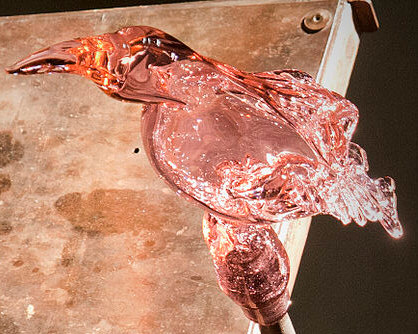
By DDauri Daniel D'Auria (Own work) [CC-BY-3.0],
via Wikimedia Commons
Once glass has been melted, it is blown out and carefully molded into shapes.
Cotton candy can also be shaped to form art, as mentioned above. Not only do
they have the basic principals in common, but you can purchase both cotton candy
and glass art at local fairs, carnivals, and amusement parks. Because of the
nature of glass blowing and cotton candy making, it was easy for craftsmen of
both to travel with their rather light equipment from place to place. In this
current time, you can walk into a gift shop and buy both for that reason.
4) Technological Advancements for Science
Understanding centrifugal force is
important in the invention of cotton candy. The machine looks like a simple toy,
however the theories behind it are anything but. Harnessing centrifugal energy
is the way that you stay in place when you are on a roller coaster and the
reason that you can spin a beaker upside down if you are moving it fast enough.
This theory has been implemented and improved in many walks of machinery,
mechanical work, and even medical equipment such as CT scanners.
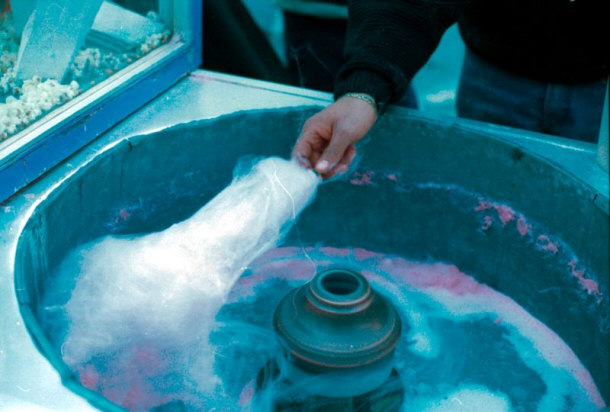
By Adamantios (Own work) [GFDL, CC-BY-SA-3.0,
via Wikimedia Commons
Given all of that, it's amazing that the basic way that we make cotton candy
has remained unchanged. The only advancements to cotton candy have been mass
production and equipment upgrades. Because of the use of force in making cotton
candy, the equipment is under a lot of stress. The faster the pan moves the more
force is being applied to the machinery. This causes vibrations that loosens
screws, make holes bigger, and otherwise cause structural failures. Making the
machines tougher has been all the major advancements in the candy process.
3) Cotton Candy, the Medical Wonder
Spinning cotton candy creates small microfibers of sugar. The process also traps air pockets into the spun sugar
that gives the cotton candy it's cottony look. This process could also be used
to spin supply vessels for skin grafts. One of the primary reasons that skin
grafts fail is a lack of blood transfer from the body to the new tissue. Adding
a vein or ventricle system that is knotted and matted like cotton candy would
ensure maximum blood flow. The small holes that happen in the cotton candy to
allow air in also will help the tissue anchor itself to the body with minimal
resistance. As NPR reported, cotton candy fibers were coated with a
silicone-based polymer. Submerging that structure in water dissolved the sugar
and left behind a three-dimensionally enmeshed architecture of microchannels.
These microchannels are what blood will travel through for the skin graft. The
medical implications are still being reviewed, however, cotton candy is
presenting an interesting and cheap way to advance patient care.
Cotton candy up close:
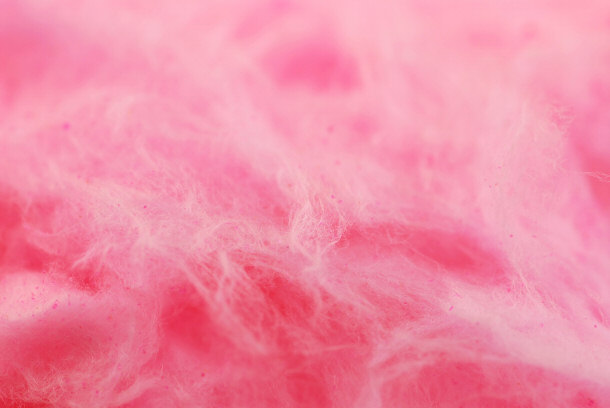
2) Dentists for Cotton Candy
The original Fairy Floss machine was patented
by candy maker John C. Warton and dentist William Morrison in 1899; in 1921, the
treat would find another dental professional willing to invest in one of the few
sugar-only candies in Josef Delarose Lascaux. Creating his own machine 15 years
after Fairy Floss debuted at the 1904 World's Fair, Lascaux avoided lawsuits by
calling his version of the treat "cotton candy," and gained popularity with the
general public by selling his product at a much lower price than his fairgoing
predecessors. Although he never received a patent on his version of the machine,
Lascaux's pricing model allowed his version to be more widely purchased and
better-known; today "fairy floss" remains the common name only in Australia,
with the rest of the world adhering to the more concise and child-friendly title
of cotton candy.
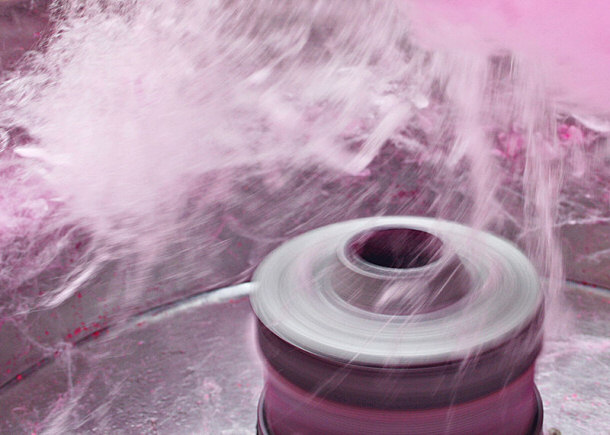
By Pp391 (Own work) [CC-BY-SA-3.0],
via Wikimedia Commons
1) You Can Make Your Own
A marvel of engineering, a creation virtually
unchanged since its inception, and a medical miracle that you can make at home.
The real magic of cotton candy is that it's so simple to make. All you need to
make your own machine is a heat source, a small motor like a servo motor, and a
rounded pan, like an angel food cake dish. Using a tea light or other sort of
heat source and a tin can or aluminum foil with holes in it will make an
adequate heat source. Remember, you only need to get the sugar to melt and it
does so at 190 degrees Fahrenheit. The only other difficult thing you will have
to do is find a way to spin your dish about fast enough to cause the strings to
come out of the holes. After that, you can enjoy your own cotton candy. If
making your own isn't in your idea of a fun afternoon, there are a lot of
options that you can buy. Many of them are not that costly either.
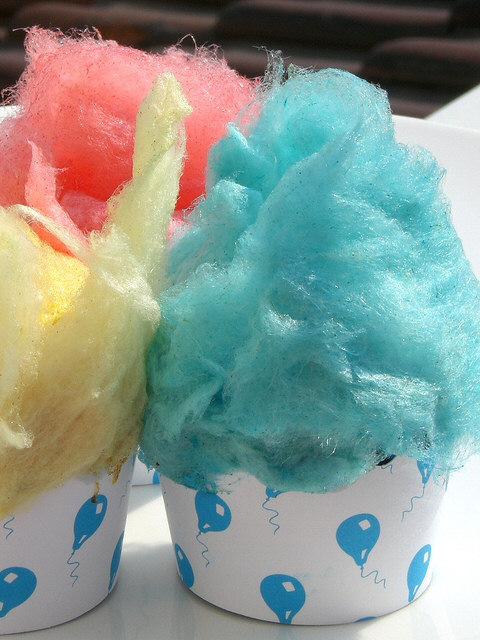
Final Words
As you can see, cotton candy is an interesting part of history that
ironically owes much of its creation to dentists. The treat was so well crafted
that other than a few changes to the machines for mechanical integrity, there
simply hasn't been much alteration in the process. Centrifugal force makes the
whole process look somewhat magical, that added to the fact that it was invented
in part by a dentist who gave it the name fairy floss. From there, very little has
changed.
Now you can buy cotton candy almost everywhere pre-packaged mostly by the
Tootsie Roll company out of Canada. Advancements in flavoring and packaging have
made cotton candy a treat that can be consumed any time of year. And that's a
good thing, considering that National Cotton Candy Day falls on Dec. 7 during a
distinctive lack of fairs in most of the United States.
General Food
15 Little Known Facts About McDonald’s
15 Surprising Facts About the History of Fast Food
15 Fascinating Facts about Mushrooms
Top 10 Must-Try Foods of France
Top 15 Foods of the Future
15 Fascinating Facts in the World of Cheese
15 Little Known Facts in the World of Cotton Candy
15 Interesting Facts About Burgers
19 Ridiculous Food Challenges Around the World
15 Unusual Things People Around the World Eat
10 Enthralling Facts about the World of Gourmet |